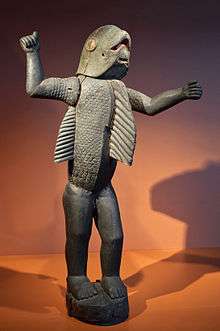Béhanzin


Béhanzin (1844 – December 10, 1906) is considered the eleventh (if Adandozan is not counted) King of Dahomey, modern-day Benin.[1] Upon taking the throne, he changed his name from Kondo. He succeeded his father, Glele, and ruled from 1889 to 1894. Béhanzin was Abomey's last independent ruler established through traditional power structures. He led the national resistance during the Dahomey War.
His symbols are the shark, the egg (a rebus of his name), and a captive hanging from a flagpole (a reference to a boastful and rebellious Nago practitioner of harmful magic from Ketou whom the king hanged from a flagpole as punishment for his pride). But, his most famous symbol is the smoking pipe. This is because he claimed that there wasn't a minute in his life, even when he was a baby, that he was not smoking.
Béhanzin was seen by his people as intelligent and courageous. He saw that the Europeans were gradually encroaching on his kingdom, and as a result attempted a foreign policy of isolating the Europeans and rebuffing them. As prince just before Glele's death, Béhanzin declined to meet French envoy Jean Bayol, claiming conflicts in his schedule due to ritual and ceremonial obligations. As a result, Bayol returned to Cotonou to prepare to go to war against Béhanzin, named king upon Glele's death. Seeing the preparations, the Dahomeans attacked Bayol's forces outside Cotonou in 1890; the French army stood fast due to superior weaponry and a strategically advantageous position. Eventually Béhanzin's forces were forced to withdraw. Béhanzin returned to Abomey, Bayol to France for a time.
The peace lasted two years, during which time the French continued to occupy Cotonou. Both sides continued to buy arms in preparation for another battle. In 1892, the soldiers of Abomey attacked villages near Grand Popo and Porto-Novo in an effort to reassert the older boundaries of Dahomey. This was seen as an act of war by the French, who claimed interests in both areas. Bayol, by now named Colonial Governor by the French, declared war on Béhanzin. The French war machine justified the aggression by characterizing the Dahomeans as savages in need of civilizing, and pointing to what it called the "human sacrifice" of the annual customs and at a king's death, and to the continued practice of slavery, as evidence of this savagery.
Some of this propaganda still exists today: in the Musee de l'Homme in the Palais de Chaillot in Paris, there is a large print, again illustrating the alleged savagery of the Dahomeans, of a battle in the war against Dahomey where a Dahomey Amazon killed a French officer by ripping out his throat with her sharpened teeth. The story is somewhat more complex, however, since the traditional accounts of the event handed down in Benin have the Amazon as a trusted wife of Béhanzin who had sworn to avenge members of the royal family who had been executed by Béhanzin for treachery after divulging battle plans in return for bribes from French agents. Further, the French officer at issue was allegedly the head of French military intelligence who committed the 'savage' act of corrupting family members to betray their own; the Amazon was reduced to using her teeth after her ammunition ran out at the battle's peak.
Through superior intelligence gathering, superior weaponry, subversion by some members of the royal family who had been corrupted by bribes, and a campaign of psychological warfare that included cutting down most of the sacred trees in the Oueme and Zou, and an unexpected attack strategy, the French succeeded in defeating Dahomey, the last of the traditional African kingdoms to succumb to European colonization. Instead of attacking Abomey directly by marching straight north from Calavi just north of Cotonou, French General Alfred Dodds attacked from Porto-Novo, moving up the Oueme valley until he was within striking distance of Abomey, via Cove and Bohicon.
The French were victorious, and in 1894, Béhanzin surrendered his person to Dodds, without signing any instrument of national surrender or treaty. He lived out the remainder of his life in exile in Martinique and Algeria. After his death, his remains were returned to Abomey.
Béhanzin was succeeded by Agoli-agbo, his distant relative and one-time Army Chief of Staff, the only potential ruler which the French were willing to instate.
References
See also
| Wikimedia Commons has media related to Behanzin. |
| Regnal titles | ||
|---|---|---|
| Preceded by Glele |
King of Dahomey 1889–1894 |
Succeeded by Agoli-agbo |
